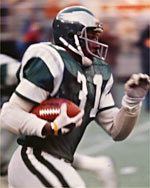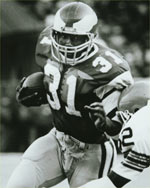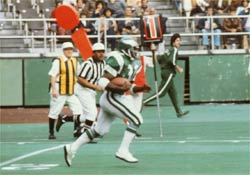Playing With Pain
|
Eagles Running Back Wilbert Montgomery Is a Gamebreaker By Rick Ostrow (The following feature appeared in a 1981 edition of Pro Magazine.) The Eagles' Wilbert Montgomery has a history of injuries-but more often than not it's Philadelphia opponents who get hurt by him.
Will Wilbert Play? And: Eagles Need Wilbert's Knee. We're not talking lead sports page stories here, mind you; we're talking 60-point type, Page One. Philadelphia is a city that takes its sports and its sports heroes so seriously that once a player enters its pantheon, his first name alone-Pete, Julius, Wilbert-becomes a sufficient peg on which to hang even the most weighty headline. Wilbert's left knee was a front-page concern because Eagles fans knew that playing the Cowboys-the streaking, hated, feared Cowboys-without him would be nothing but a three-hour quest for frostbite. "I know Wilbert will be out there Sunday come hell or high water," quarterback Ron Jaworski said bravely on Thursday. Only after the notepads and microphones had drifted away did he unstiffen his upper lip and admit to no one in particular, "My God, he better be." But if there were a cat-and-mouse game the Eagles were playing, it was without the knowledge of the cheese. Montgomery's best turned out to be reward enough for the city's days of nervous anxiety. The Eagles' defense forced an immediate three-and-out series. After Jaworski's first-down pass to Rodney Parker fell incomplete, it happened. Montgomery surveyed the Cowboys' Nickel defense from his spot at the top of the I, took the handoff, saw things clog up along the left side of the line where the play was designed to go, stutter-stepped toward the right side behind Jerry Sisemore's crushing block on Ed Jones, and was gone. Poof! Just like that, with the elusive grace that has allowed the great running backs consistently to make our vocabulary appear feeble. Forty-two yards untouched. In the fourth quarter, with the threat of all those spirit-crushing Cowboys comebacks still chilling the hearts of the 70,696 already-chilled bodies in the stands, Montgomery's knee finally gave out. But not until he had reversed the trail of his first-quarter run, taking a toss right, squirting left out of the hands of D.D. Lewis, and running into the open field, which is his easel. He managed a 55-yard run before his leg folded, but the momentum and field position had tilted irreversibly the Eagles' way. When it was over, Montgomery had run for 194 yards on 26 carries. The total was only 2 yards short of the championship game record former Eagles halfback Steve Van Buren had set against the Rams in 1949. Pro Football Hall of Fame member Van Buren held 13 Eagles records when he retired in 1951. Most of them stood for more than 25 years, but if Montgomery remains healthy, Van Buren will be fortunate to retain a handful of them. Hip, groin, hamstring, and knee problems conspired to keep him out of four complete midseason games and parts of three others. Even after he returned to what passed for good health in the twelfth game of the season, he was forced to the sidelines at least once in every remaining game. The injuries and Dick Vermeil's understandable concern of the long-term durability of his most dangerous offensive weapon combined to cut Montgomery's rushing total nearly in half last year, down to 778 yards in 193 attempts from the 1,512 in 338 that he had accumulated in 1979, his second year as a starter.
Guilt that, in the second year of a hefty three-year contract, he finally was earning big money but was doing less each week for it than he ever had. "Thoughts like that couldn't help but creep into your mind when you're sittin' in there," Montgomery admitted. "Running backs play four, five years, then they're out of the league. You notice that and try to forget it, but when you're not playin', you think it's your time that's come." But football injuries were old hat to Montgomery even before he entered the NFL. He broke his leg playing football with friends in the schoolyard as a fourth-grader in Greenville, a quiet town of 50,000 in the Mississippi delta region near the Arkansas border. That scared him off the game for a while. "When you're little, you think your leg is like a stick," he said a few years ago, reminiscing about his childhood. "You break it in half, it's gonna fall in two pieces. I thought, 'Oh-oh, I'm gonna have a cast on my leg forever.' I remember the next few years, kids callin' me from the schoolyard wantin' me to play football with 'em. I'd always say no." By the time he reached eighth grade, however, his curiosity about the game had returned. He wanted to play for the Greenville High School team, but he knew his mother would object. An older brother had separated both his shoulders playing football, and Gladys Montgomery was extremely protective of Wilbert. So he persuaded a girl in his class to forge his mother's signature on the parental permission slip, and he made a deal with his friends not to tell his mother what he was doing with his after-school time. "After practice, I'd come home and she would ask where I'd been," he recalled with a sly smile. "I'd say I was at a friend's house. We played our games Friday night, so I'd say,'Momma, I'm goin' out for a while. I'll be home by 10:30.' When we played the coast-places like Gulfport and Biloxi-we'd stay overnight and bus back the next day. Those nights, I told my mother not to worry, I was sleepin' over at a friend's house. If I came home limpin', I'd say we did it foolin' around. She'd always say, 'Wilbert, you know I don't like it when you play so rough.'" Keeping up the charade got progressively more difficult. Playing both ways, he made all-state as a defensive back and was rushing for 100 yards a game even then. For almost two years, his mother thought that the Greenville Democrat-Times had a mysterious void because it always arrived without a sports page. Montgomery ripped the sports section out every night before his mother came home from work. He stashed the trophies in a closet at his grandmother's. By the time his junior year arrived and the colleges became interested, he knew he had to fess up. "I finally told her I was playing football, and she wasn't happy," he says. "She argued for a long time, but when I told her it might win me a scholarship to college, she said, 'All right, go ahead, but don't come runnin' to me when you get hurt.' I never did. I still don't."
With Montgomery at running back, Abilene Christian won the NAIA Division I national title his first year. But he was sidelined by a dislocated shoulder his sophomore year, by a badly bruised shoulder his junior year, and by a deep thigh bruise as a senior. Montgomery was hampered so severely in college that he only could produce "feeble" stats such as 14 100-yard games, 3,047 career yards, touchdown runs in 32 of the 35 games in which he played, and an all-time record collegiate career total of 70 touchdowns plus six more in postseason play. With numbers like that, the interest of the pro scouts naturally piqued. But the linebacker's helmet that had bruised his thigh so badly as a senior not only put his leg in a cast for six weeks but also left calcium deposits there. The New England Patriots invited Montgomery in for a predraft workout. Coach Chuck Fairbanks liked what he saw, but the team doctor saw the calcium and warned that Montgomery would require an operation, the results of which he couldn't guarantee. When Fairbanks told Montgomery that he might have to sit out a year and that his pro career was a question mark, Montgomery, 22 and out of the South for the first time in his life, cried. The word got out that kid with the flashy statistics was injury prone. One scouting combine classified him as a reject, which was okay with Dick Vermeil because rejects were something he knew all about. He was into his second draft in Philadelphia after arriving from UCLA in 1976 and had yet to experience three rounds. But he had three selections in the sixth round that year, and with the second one, a pick he'd obtained from the Bears, he drafted Wilbert Montgomery. Montgomery spent his rookie year as a kickoff specialist, leading the NFL with a26.3-yard average. In the final game of the year against the Jets, Vermeil says he "finally got smart enough to start him at running back," and Montgomery responded with 103 yards and 2 touchdowns in a 27-0 victory. The rest is Eagles history. Montgomery broke Van Buren's team single-season rushing record with 1,220 yards in 1978 and shattered his own mark the next year with 1,512, making the NFL Pro Bowl team both years. Last season was salvaged by the Dallas performance. "I thought it would be a dogfight," he says. "Games with Dallas always are. I went in there with the idea that anything I got, I'd have to earn." It was, in other words, no different from anything else in Montgomery's life. It certified for the nation his credentials as a gamebreaker, a term he'll wear only if he's allowed to define it. "When a team gives you a lot of respect, you're a gamebreaker," he says softly. "I think I'm one, 'cause I play hard and teams sure do get excited when they shut me down." |
Red Hickey unveils shotgun
Flashback: Montana outduels Elway
Two future Hall of Famer quarterbacks battled in a famous Monday Night game.


 Four days before the
Four days before the  But an even greater toll was exacted on Montgomery's fragile psyche. He would troop in dutifully to the Eagles' locker room each weekday at 8 a.m. for his 12-hour sessions with trainer Otho Davis and his staff, but while his lower body soaked in saline solutions and the latest rehabilitative technology, his 26-year-old mind stewed in self-doubt and guilt.
But an even greater toll was exacted on Montgomery's fragile psyche. He would troop in dutifully to the Eagles' locker room each weekday at 8 a.m. for his 12-hour sessions with trainer Otho Davis and his staff, but while his lower body soaked in saline solutions and the latest rehabilitative technology, his 26-year-old mind stewed in self-doubt and guilt. The college he finally selected was Jackson State, but when he arrived, he found a backfield populated by Walter Payton, Rod Phillps, Ricky Young, and Ricky Patton, all of whom eventually wound up in the NFL. Montgomery didn't stay long, slipping out one weekend to get his laundry from home and winding up at Abilene Christian, a small college in Texas that had no problem finding a place for him in its lineup.
The college he finally selected was Jackson State, but when he arrived, he found a backfield populated by Walter Payton, Rod Phillps, Ricky Young, and Ricky Patton, all of whom eventually wound up in the NFL. Montgomery didn't stay long, slipping out one weekend to get his laundry from home and winding up at Abilene Christian, a small college in Texas that had no problem finding a place for him in its lineup.